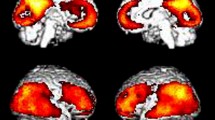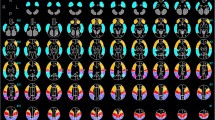Abstract
Purpose
Previous cerebral blood flow and glucose metabolism studies suggest that the basal ganglia or thalamus is involved in the pathogenesis of paroxysmal kinesigenic choreoathetosis (PKC). However, the underlying cerebral abnormalities in idiopathic PKC have not been elucidated. To localise cerebral perfusion abnormalities in PKC, we performed interictal brain perfusion 99mTc-ethylcysteinate dimer (ECD) single-photon emission computed tomography (SPECT) in PKC patients and in normal controls.
Methods
Sixteen patients with idiopathic PKC and 18 age- and sex-matched normal controls were included. The patients were de novo diagnosed as having PKC, or had not taken medication for at least 3 months; none of them had structural abnormalities on MRI. Patients had a history of PKC attacks of a duration not exceeding 5 min and starting either on one side or on both sides of the body. These attacks were always induced by a sudden initiation of voluntary movement. PKC attacks were recorded in a hospital after being induced by neurology staff in 13 of the 16 patients. Interictal brain perfusion 99mTc-ECD SPECT was performed in all 16 patients and 18 normal controls. Differences between the cerebral perfusion in the PKC group and the normal control group were tested by statistical parametric mapping. Student’s t test was used for inter-group comparisons.
Results
Compared with normal controls, patients with idiopathic PKC showed interictal hypoperfusion in the posterior regions of the bilateral caudate nuclei (false discovery rate-corrected P<0.001 with a small volume correction).
Conclusion
This study showed that cerebral perfusion abnormality of bilateral caudate nuclei is present in idiopathic PKC.

Similar content being viewed by others
References
Demirkiran M, Jankovic J. Paroxysmal dyskinesias: clinical features and classification. Ann Neurol 1995;38:571–9
Kertesz A. Paroxysmal kinesigenic choreoathetosis. An entity within the paroxysmal choreoathetosis syndrome. Description of 10 cases, including 1 autopsied. Neurology 1967;17:680–90
Ra SO, Hwang SC, Kim DH, Choi MS, Park KH, Kim SW. A case of paroxysmal dystonic choreoathetosis. J Korean Neurol Assoc 1991;9:107–11
Fahn S. The paroxysmal dyskinesia. In: Marsden CD, Fahn S (eds) Movement disorder 3. Oxford: Butterworth-Heinemann; 1994. p. 10–45
Lombroso CT. Paroxysmal choreoathetosis: an epileptic or non-epileptic disorder? Ital J Neurol Sci 1995;16:271–7
Ko CH, Kong CK, Ngai WT, Ma KM. Ictal 99mTc ECD SPECT in paroxysmal kinesigenic choreoathetosis. Pediatr Neurol 2001;24:225–7
Hayashi R, Hanyu N, Yahikozawa H, Yanagisawa N. Ictal muscle discharge pattern and SPECT in paroxysmal kinesigenic choreoathetosis. Electromyogr Clin Neurophysiol 1997;37:89–94
Shirane S, Sasaki M, Kogure D, Matsuda H, Hashimoto T. Increased ictal perfusion of the thalamus in paroxysmal kinesigenic dyskinesia. J Neurol Neurosurg Psychiatry 2001;71:408–10
Volonte MA, Perani D, Lanzi R, Poggi A, Anchisi D, Balini A, et al. Regression of ventral striatum hypometabolism after calcium/calcitriol therapy in paroxysmal kinesigenic choreoathetosis due to idiopathic primary hypoparathyrodism. J Neurol Neurosurg Psychiatry 2001;71:691–5
Iwasaki Y, Nakamura T, Hamada K. Late-onset of idiopathic paroxysmal kinesigenic choreoathetosis: a case report. Rinsho Shinkeigaku 2004;44:365–8
Chang L. A method for attenuation correction in computed tomography. IEEE Trans Nucl Sci 1987;25:638–43
Demirkiran M, Jankovic J. Paroxysmal dyskinesias: clinical features and classification. Ann Neurol 1995;38:571–9
DeLong MR, Georigopoulos AP, Crutcher MD, Nitchell SJ, Richardson RT, Alexander GE. Functional organization of the basal ganglia: contributions of single-cell recording studies. In: Evered D, O’Connor M (eds) Functions of the basal ganglia: Ciba Foundation Symposium. London: Pitman; 1984. p. 64–82
Alexander GE, Crutcher MD, Delong MR. Basal ganglia–thalamocortical circuits: parallel substrates for motor, oculomotor, prefrontal and limbic functions. Prog Brain Res 1990;85:119–46
Mink JW. The basal ganglia: focused selection and inhibition of competing motor programs. Prog Neurobiol 1996;50:381–425
Mink JW. The basal ganglia and involuntary movements. Arch Neurol 2003;60:1365–8
Vital A, Bouillot S, Burbaud P, Ferrer X, Vital C. Chorea-acanthocytosis: neuropathology of brain and peripheral nerve. Clin Neuropathol 2002;21:77–81
Mitchell IJ, Jackson A, Sambrook MA, Crossman AR. The role of the subthalamic nucleus in experimental chorea. Evidence from 2-deoxyglucose metabolic mapping and horseradish peroxidase tracing studies. Brain 1989;112:1533–48
Crossman AR, Mitchell IJ, Sambrook MA, Jackson A. Chorea and myoclonus in the monkey induced by gamma-aminobutyric acid antagonism in the lentiform complex. The site of drug action and a hypothesis for the neural mechanisms of chorea. Brain 1988;111:1211–33
Lang AE, Loranzo AM, Montgomery E, Duff J, Tasker R, Hutchinson W. Posteroventral medial pallidotomy in advanced Parkinson’s disease. N Engl J Med 1997;337:1036–42
Suarez JI, Metman LV, Reich SG, Doughtery PM, Hallett M, Lenz FA. Palliditomy for hemiballismus: efficacy and characteristics of neuronal activity. Ann Neurol 1997;42:807–11
Vitek JL. Pathophysiology of dystonia: a neuron model. Mov Disod 2002;17:49–62
Perlmutter JS, Tempel LW, Balck KJ, Parkinson D, Todd RD. MPTP induced dystonia and parkinsonism: clues to the pathophysiology of dystonia. Neurology 1997;49:1432–8
Joo EY, Hong SB, Lee EK, Tae WS, Kim JH, Seo DW, et al. Regional cerebral hyperperfusion with ictal dystonic posturing: ictal–interictal SPECT subtraction. Epilepsia 2004;45:686–9
Whiteside SP, Port JD, Abramowitz JS. A meta-analysis of functional neuroimaing in obsessive–compulsive disorder. Psychi Resea Neuroimage 2004;132:69–79
Boecker H, Kuwert T, Langen KJ, Lange HW, Czech N, Ziemons K, et al. SPECT with HMPAO compared to PET with FDG in Huntington disease. J Comput Assist Tomogr 1994;18:542–8
Acknowledgements
This work was supported by a grant (No. HMP-03-PJ1-PG3-21300-0033) of the Good Health R&D Project, Ministry of Health & Welfare, Republic of Korea.
Author information
Authors and Affiliations
Corresponding author
Rights and permissions
About this article
Cite this article
Joo, E.Y., Hong, S.B., Tae, W.S. et al. Perfusion abnormality of the caudate nucleus in patients with paroxysmal kinesigenic choreoathetosis. Eur J Nucl Med Mol Imaging 32, 1205–1209 (2005). https://doi.org/10.1007/s00259-005-1814-z
Received:
Accepted:
Published:
Issue Date:
DOI: https://doi.org/10.1007/s00259-005-1814-z




